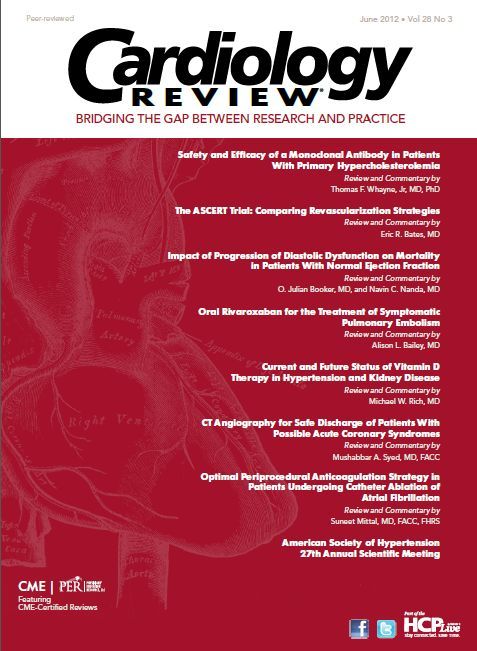Publication
Article
Cardiology Review® Online
Safety and Efficacy of a Monoclonal Antibody in Patients With Primary Hypercholesterolemia

Thomas F. Whayne, Jr, MD, PhD
Review
M
cKenney J, Koren MJ, Kereiakes DJ, Hanotin C, Ferrand A-C, Stein EA. Safety and efficacy of a monoclonal antibody to proprotein convertase subtilisin/kexin type 9 serine protease, SAR236553/REGN727, in patients with primary hypercholesterolemia receiving ongoing stable atorvastatin therapy. J Am Coll Cardiol. doi:10.1016/j.jacc.2012.03.007.
In their article, McKenney et al have evaluated the efficacy of a monoclonal antibody to proprotein convertase subtilisin/kexin type 9 serine protease (PCSK9).1 The normal function of PCSK9 is to decrease low-density lipoprotein receptor (LDLR) levels by binding to the LDLRs. The function of these receptors is to initiate attachment of LDL to cells as the first step in LDL metabolism.2 With the receptors bound by PCSK9, there is an increase in LDL because it is metabolized less. The monoclonal antibody to PCSK9, known as 5 SAR236553/REGN727 (SAR236553), is highly specific. In studies with hypercholesterolemia patients, SAR236553 has been shown to decrease LDL on a dose-dependent basis.1 Research suggests that some mutations of PCSK9 can result in autosomal dominant familial hypercholesterolemia. 3 Other mutations can be associated with decreased LDL and an associated reduction in cardiovascular disease (CVD).4 The apparent mechanism is that some PCSK9 mutations with increased PCSK9 function decrease LDL receptor levels in the liver, with a resultant increase in plasma LDL. On the other hand, other mutations decrease PCSK9 function, leading to increased LDL receptors and a consequent reduction in plasma LDL. Thus, the monoclonal antibody SAR236553 binds to PCSK9, inhibiting its activity and thereby resulting in a favorable increase in LDL receptors with subsequent plasma LDL reduction.
In the current study McKenney et al test the ability of SAR236553 to lower LDL at starting levels of LDL >100 mg/dL while patients are taking stable atorvastatin therapy.1 Stable therapy was defined as atorvastatin 10, 20, or 40 mg/d for >6 weeks prior to initiating the study.1 The goal was then to evaluate the effectiveness of various SAR236553 dosing regimens versus placebo over a treatment period of 12 weeks when added to the stable atorvastatin regimen. An additional objective was to evaluate the effects of SAR236553 on other lipid parameters such as apolipoprotein B (Apo-B) and non-high density lipoproteins (non-HDLs).
A total of 183 patients meeting the study criteria were randomized to subcutaneous placebo every 2 weeks; subcutaneous SAR236553 every 2 weeks in a dose of 50 mg, 100 mg, or 150 mg; or subcutaneous SAR236553 in a dose of 200 mg or 300 mg every 4 weeks. SAR236553 was alternated with placebo for a total treatment period of 12 weeks.
There was a significant percentage decrease in LDL from baseline by 30.5%, 53.6%, and 62.9% at 2 weeks with SAR236553 50 mg, 100 mg, and 150 mg every 2 weeks, respectively. At 12 weeks, there were further LDL reductions, attaining percentage reductions of 39.6%, 64.2%, and 72.4% at 50 mg, 100 mg, and 150 mg, respectively.
The 4-week dosing regimen was less effective. The authors concluded that the 72.4% LDL reduction attained with SAR236553 given subcutaneously every 2 weeks in a dose of 150 mg represented essentially the most effective lipid-lowering approach observed to date. Therefore, such promising results for LDL reduction would appear to warrant more extensive and effectiveness.
References
1. McKenney J, Koren MJ, Kereiakes DJ, et al. Safety and efficacy of a monoclonal antibody to proprotein convertase subtilisin/ kexin type 9 serine protease, SAR236553/
REGN727, in patients with primary hypercholesterolemia receiving ongoing stable atorvastatin therapy [published online ahead of print March 28, 2012]. J Am Coll Cardiol.
2. Peterson AS, Fong LG, Young SG. PCSK9 function and physiology. J Lipid Res. 2008;49:1152-1156.
3. Leren TP. Mutations in the PCSK9 gene in Norwegian subjects with autosomal dominant hypercholesterolemia. Clin Genet. 2004;65:419-422.
4. Cohen JC, Boerwinkle E, Mosley TH Jr, et al. Sequence variations in PCSK9, low LDL, and protection against coronary heart disease. N Engl J Med. 2006;354:1264-1272.
5. The Lipid Research Clinics Coronary Primary Prevention Trial results: I: reduction in incidence of coronary heart disease. JAMA. 1984;251:351-364.
6. The Lipid Research Clinics Coronary Primary Prevention Trial results: II: the relationship of reduction in incidence of coronary heart disease to cholesterol lowering.
JAMA. 1984;251:365-374.
7. Blankenhorn DH, Johnson RL, Nessim SA, et al. The Cholesterol Lowering Atherosclerosis Study (CLAS): design, methods, and baseline results. Control Clin Trials. 1987;8:356-387.
8. Blankenhorn DH, Nessim SA, Johnson RL, et al. Beneficial effects of combined colestipol-niacin therapy on coronary atherosclerosis and coronary venous bypass
grafts. JAMA. 1987;257:3233-3240.
9. Buchwald H, Stoller DK, Campos CT, et al. Partial ileal bypass for hypercholesterolemia: 20- to 26-year follow-up of the first 57 consecutive cases. Ann Surg.
1990;212:318-329; discussion 329-331.
10. Buchwald H, Varco RL, Boen JR, et al. Effective lipid modification by partial ileal bypass reduced long-term coronary heart disease mortality and morbidity: fiveyear
posttrial follow-up report from the POSCH: Program on the Surgical Control of the Hyperlipidemias. Arch Intern Med. 1998;158:1253-1261.
11. Schonfeld G. The hypobetalipoproteinemias. Annu Rev Nutr. 1995;15:23-34.
12. Wiviott SD, Cannon CP, Morrow DA, et al. Can low-density lipoprotein be too low? The safety and efficacy of achieving very low low-density lipoprotein with intensive
statin therapy: a PROVE IT-TIMI 22 substudy. J Am Coll Cardiol. 2005;46:1411- 1416.
13. Hsia J, Macfadyen JG, Monyak J, et al. Cardiovascular event reduction and adverse events among subjects attaining low-density lipoprotein cholesterol <50 mg/dl with rosuvastatin. The JUPITER Trial (Justification for the Use of Statins in Prevention: an Intervention Trial Evaluating Rosuvastatin). J Am Coll Cardiol. 2011;57:1666-1675.
14. Davignon J. Beneficial cardiovascular pleiotropic effects of statins. Circulation. 2004;109:III39-III43.
15. Randomised trial of cholesterol lowering in 4444 patients with coronary heart disease: the Scandinavian Simvastatin Survival Study (4S). Lancet. 1994;344:1383-1389.
16. The Long-Term Intervention with Pravastatin in Ischaemic Disease (LIPID) Study Group. Prevention of cardiovascular events and death with pravastatin in patients with coronary heart disease and a broad range of initial cholesterol levels. N Engl J Med. 1998;339:1349-1357.
17. Shepherd J, Cobbe SM, Ford I, et al; West of Scotland Coronary Prevention Study Group. Prevention of coronary heart disease with pravastatin in men with hypercholesterolemia. N Engl J Med. 1995;333:1301-1307.
18. Sacks FM, Pfeffer MA, Moye LA, et al; Cholesterol and Recurrent Events Trial investigators. The effect of pravastatin on coronary events after myocardial infarction
in patients with average cholesterol levels. N Engl J Med. 1996;335:1001-1009.
19. Grundy SM, Cleeman JI, Merz CN, et al. Implications of recent clinical trials for the National Cholesterol Education Program Adult Treatment Panel III guidelines.
Circulation. 2004;110:227-239. 20. Ghosh RK, Ghosh SM. Current Status of CETP Inhibitors in the Treatment of Hyperlipidemia: an update. Curr Clin Pharmacol.
2012;7(2)102-110.
Commentary
Safety/Efficacy of a Monoclonal AntibodyTreatment in Hypercholesterolemia Patients
The lipid hypothesis of benefit from LDL reduction was well established in the mid-1980s with publication of the results from the Lipid Research Clinics Coronary Primary Prevention Trial (LRCCPPT). 5,6 Multiple other studies have shown the benefit of reducing the percentage of LDL, such as the Cholesterol Lowering Atherosclerosis Study (CLAS), which used colestipol plus nicotinic acid and demonstrated coronary plaque regression by quantitative coronary angiography.7,8 Ileal bypass has been shown to result in significant lowering of LDL in the Program on the Surgical Control of the Hyperlipidemias (POSCH) study,9,10 which reported lowering LDL by 37.7% and significantly decreasing 5-year mortality including coronary heart disease (CHD) mortality and/or nonfatal myocardial infarction.

Hypobetalipoproteinemia is a specific familial condition defined by having LDL cholesterol equal to or less than the fifth percentile. Epidemiologic studies have shown that despite having some other associated medical problems, these individuals have a lower-thanaverage risk for CVD.11 LRC-CPPT, POSCH, and hypobetalipoproteinemia appear to be instances where essentially only LDL is affected and thereby show the benefit of decreased LDL with no associated significant metabolic or pleiotropic effects. This also essentially appears to be the case with CLAS since the nicotinic acid used most likely added little benefit (over and above its further contribution to colestipol) in decreasing LDL. The Pravastatin or Atorvastatin Evaluation and Infection Therapy-Thrombolysis in Myocardial Infarction
22 (PROVE-IT-TIMI 22) study looked at subgroups of LDL <40 mg/dL and LDL 40 to 60 mg/dL in acute coronary syndrome patients. 12 These subgroups were in comparison with higher LDL levels present in the rest of the PROVEIT-TIMI 22 study, and it was established that there were fewer major cardiac events in the lower LDL groups; this favorable decrease was statistically significant.12 It was concluded that, compared with PROVE-IT-TIMI 22 patients treated to an accepted LDL goal of 80 to 100 mg/ dL, the lower LDL levels that were achieved resulted in improved clinical benefit with no adverse effects. A similar result was obtained in a subgroup of the Justification for the Use of Statins in Prevention: an Intervention Trial Evaluating Rosuvastatin (JUPITER) study of subjects attaining an LDL of <50 mg/dL.13 These subjects were found to have significantly fewer CV events as compared with the complete JUPITER study group. In addition to currently being the single most effective class of medications to lower LDL, statins offer additional CV risk reduction from their multiple pleiotropic effects.14 These pleiotropic effects include improved endothelial dysfunction, increased nitric oxide levels, antioxidant properties, decreased inflammation, and atherosclerotic plaque stabilization. Several classic outcomes studies have established CV risk reduction by LDL reduction using statins.15-18 These outcomes studies offer further proof of the value of percentage lowering of LDL, enhanced by the pleiotropic effects of the statin class of medications.
Therefore, the studies of LDL lowering that have been cited—with or without statins and their pleiotropic effects—strongly support the importance of targeting LDL. For the patient with an established high CVD risk, such as diabetes mellitus, Grundy et al defined the attainment of even an LDL level of 70 mg/dL as desirable. 19 In those high-CVD-risk patients with an LDL level already close to 70 mg/dL, the available evidence supports an even further reduction in LDL to well below this level.
This background information can be used to place the potential impact of the report of McKenney et al into context.1 Without question, SAR236553 will effectively reduce LDL by percentages currently not attainable. Much needs to be learned by further clinical experience regarding any secondary effects. However, the evidence available
supports the value of the marked LDL reduction by SAR236553 unless some undocumented, secondary effects complicate the therapeutic approach of binding PCSK9 to attain significant LDL reduction. Such studies offer an exciting glimpse of a future frontier in decreasing CV disease risk, while getting closer to the apparent next frontier in the field, which is increasing high density lipoprotein (HDL) by the cholesterol ester transferase protein inhibitors (anacetrapib and dalcetrapib) currently being evaluated in clinical trials.20 Although statins have changed the practice of CV medicine and offered patients much benefit, much remains to be done to prevent CV events. New classes of medications such as the monoclonal antibody SAR236553 will, of course, bring some new problems for the patient and clinician, such as cost and a more inconvenient delivery injection formulation rather than as a daily, oral medication. Nevertheless, the potential of SAR236553 to block PCSK9 is exciting and offers an additional, promising approach to possibly improve the lives of patients at risk for or ravaged by atherosclerotic disease.
About the Authors
Thomas F. Whayne, Jr, MD, PhD, is professor of internal medicine in the Division of Cardiovascular Medicine at the Gill Heart Institute at the University of Kentucky in Lexington. He received his MD from the University of Pennsylvania, and did his internships and residency at The New York Hospital-Cornell Medical Center. Dr.Whayne has a PhD in Biochemistry from the University of California in San Francisco. He has been named one of America’s Top Physicians since 2004 and a Top Cardiologist since 2006. He is fluent in Spanish and has authored numerous publications in both Spanish and English and presented his work nationally and internationally.
